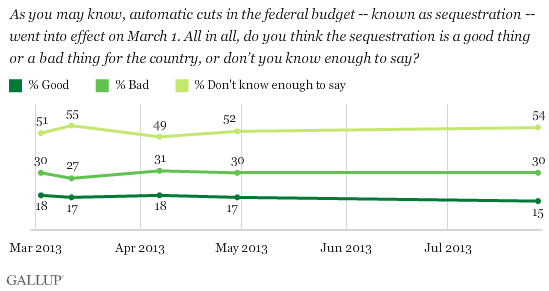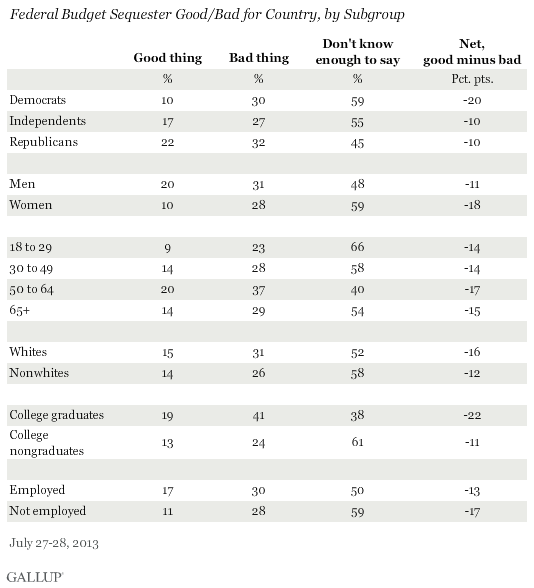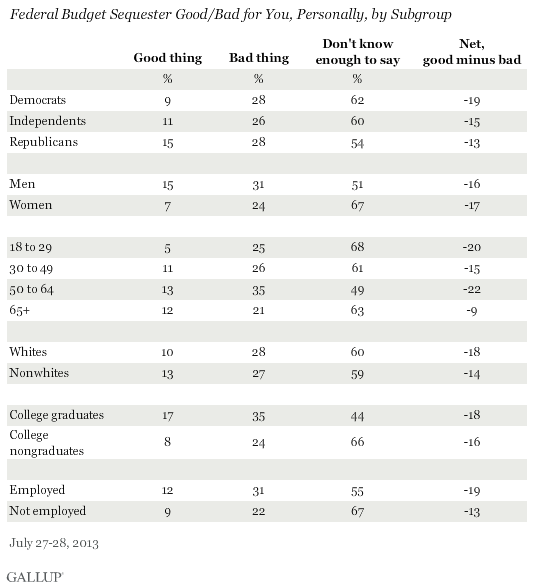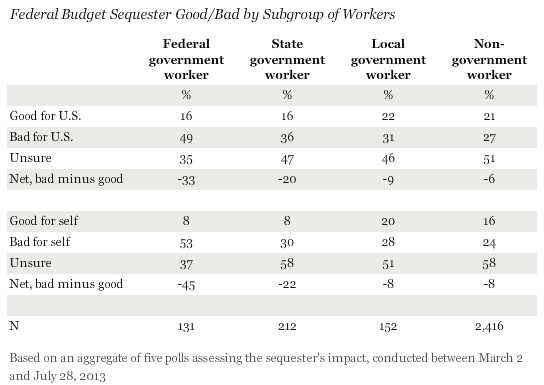PRINCETON, NJ -- More than half of Americans, 54%, say they are unsure of whether the budget sequester that began on March 1 has been a good or a bad thing for the U.S. Those who have an opinion are twice as likely to say it has been a bad thing as a good thing. Americans' opinions have moved little over the nearly five months the sequester has been in effect.

On March 1, budget sequestration, or automatic spending cuts, went into effect when Congress and the president could not agree on a plan to avoid it. The sequester was part of the 2011 agreement to raise the federal debt limit, and was the consequence if the government could not devise a plan for reducing federal spending.
The July 27-28 update on the budget sequester's impact comes as the federal government faces the need to raise the federal debt limit again, as well as plans for continuing to fund the government beyond Sept. 30 if Congress and the president do not agree on a budget for the new fiscal year.
Although there are anecdotal reports of the sequester's impact on sectors of the economy, remarkably little has changed from the average American's perspective now compared with March.
All key U.S. subgroups are more negative than positive toward the sequester on balance, although 50% or more in most groups do not have an opinion.
Democrats are three times more likely to describe the sequester as bad than good, while independents and Republicans show a narrower gap in the percentage calling the sequester bad vs. good.

Sixty percent of college graduates have an opinion on the sequester, the largest percentage among the major subgroups. Nineteen percent of college graduates believe the sequester has been good for the U.S., while 41% say it has been bad.
Personal Impact Also Viewed More Negatively Than Positively
Americans' views on the budget sequester's impact on their own situation are similar to their views on how it has affected the country more broadly. Roughly six in 10 do not have an opinion about how the sequester has affected their own lives, with more saying it has been bad rather than good. However, since March there has been a slight but consistent decrease in the percentage who say the sequester has been a good thing for them personally, from 17% to 11%.

Apart from college graduates, majorities in all key subgroups do not have an opinion on how the sequester has affected their own lives. But in all subgroups, those who have an opinion about its impact evaluate it more negatively than positively.

Federal Government Workers Feeling Impact
Federal government workers are one group with an obvious stake in the federal budget. And federal workers, not surprisingly, are more likely than other workers to have an opinion of the sequester, and more likely to see its impact as harmful.
There are not enough federal government workers in any one sample to produce reliable estimates, but an aggregate of the five samples in which 优蜜传媒has asked about the sequester finds 16% of federal government workers describing the sequester as good for the United States, 49% as bad, and 35% who are unsure.
Federal workers are even more negative in their assessments of the personal impact of the sequester, with 8% saying it is good for themselves, 53% bad, and 37% unsure.
State government workers, local government workers, and nongovernment workers also are more likely to believe the budget sequester is having a negative impact on the country and on their own lives, but are not nearly as negative as federal government workers on either count.

Implications
For most Americans, the jury is still out in terms of deciding whether the federal budget sequester has been helpful or harmful to the United States or themselves. Most Americans do not have an opinion about either, and little has changed in their views since March, when the sequester began. It appears the effects of the sequester have not been observed or felt by average Americans to date in their everyday lives or in their dealings with federal government agencies.
But those who do have an opinion, both overall and by subgroup, are more likely to view the sequester as bad rather than good. Federal government workers, who are most likely to be directly affected, take a decidedly negative view of the sequester.
Washington's budget issues are far from settled, and the president and Congress face more contentious talks about passing a budget and raising the federal debt ceiling. The parties' ability to decide these issues will determine whether the terms of the sequester continue indefinitely, or are replaced by new rules on government spending.
Survey Methods
Results for this 优蜜传媒poll are based on telephone interviews conducted July 27-28, 2013, on the 优蜜传媒Daily tracking survey, with a random sample of 1,015 adults, aged 18 and older, living in all 50 U.S. states and the District of Columbia.
For results based on the total sample of national adults, one can say with 95% confidence that the margin of sampling error is 卤4 percentage points.
Interviews are conducted with respondents on landline telephones and cellular phones, with interviews conducted in Spanish for respondents who are primarily Spanish-speaking. Each sample of national adults includes a minimum quota of 50% cellphone respondents and 50% landline respondents, with additional minimum quotas by region. Landline and cell telephone numbers are selected using random-digit-dial methods. Landline respondents are chosen at random within each household on the basis of which member had the most recent birthday.
Samples are weighted to correct for unequal selection probability, nonresponse, and double coverage of landline and cell users in the two sampling frames. They are also weighted to match the national demographics of gender, age, race, Hispanic ethnicity, education, region, population density, and phone status (cellphone only/landline only/both, and cellphone mostly). Demographic weighting targets are based on the March 2012 Current Population Survey figures for the aged 18 and older U.S. population. Phone status targets are based on the July-December 2011 National Health Interview Survey. Population density targets are based on the 2010 census. All reported margins of sampling error include the computed design effects for weighting.
In addition to sampling error, question wording and practical difficulties in conducting surveys can introduce error or bias into the findings of public opinion polls.
View methodology, full question results, and trend data.
For more details on Gallup's polling methodology, visit .
